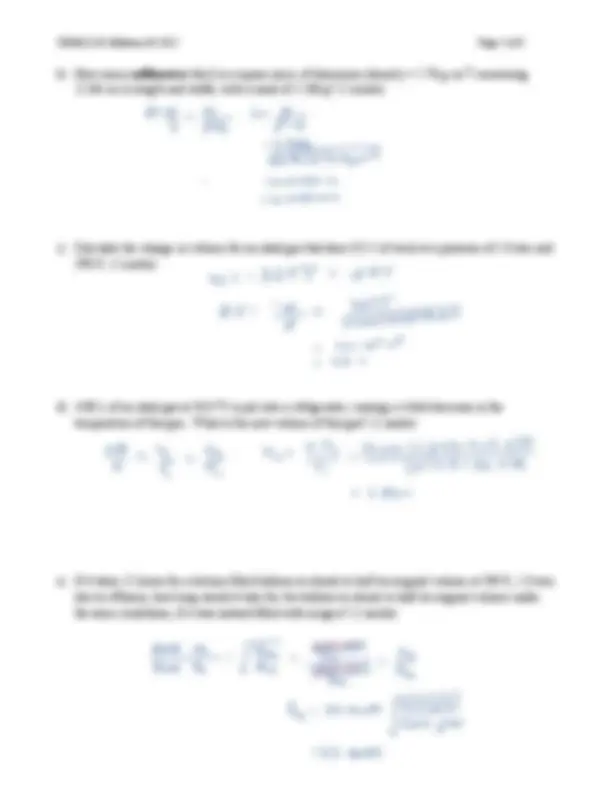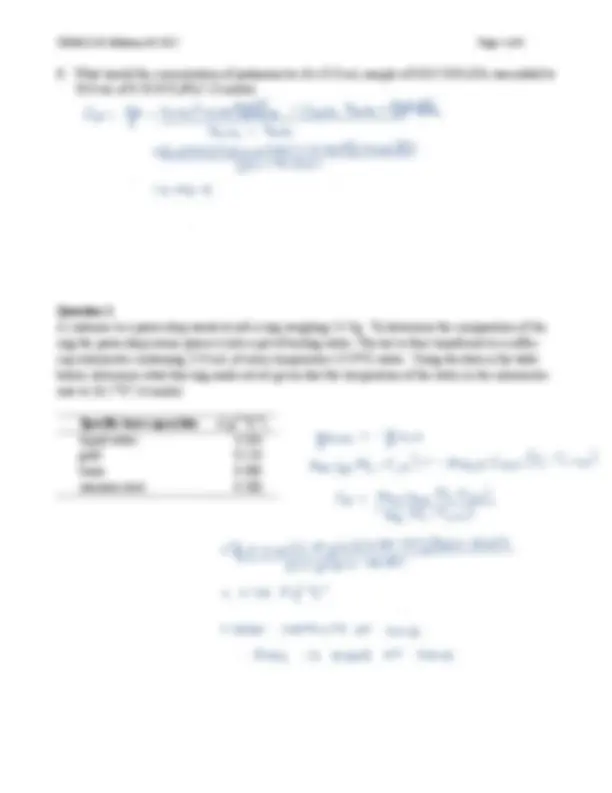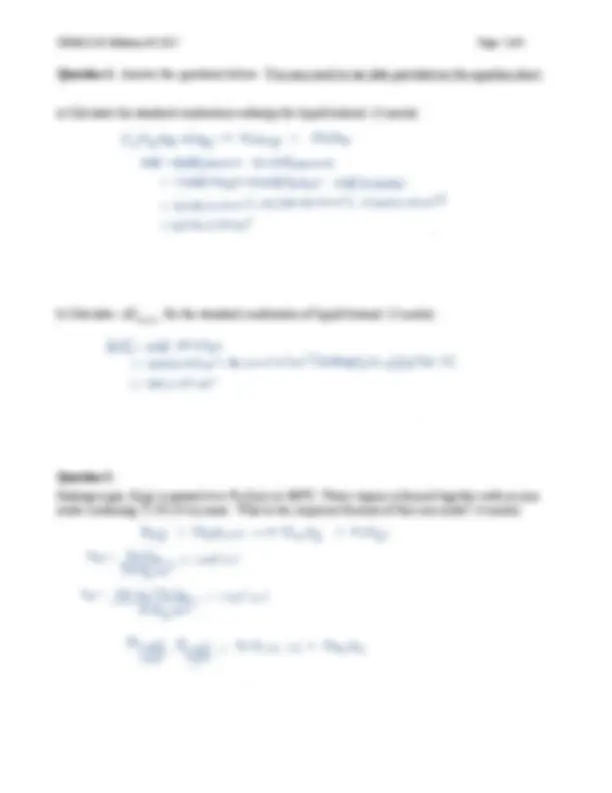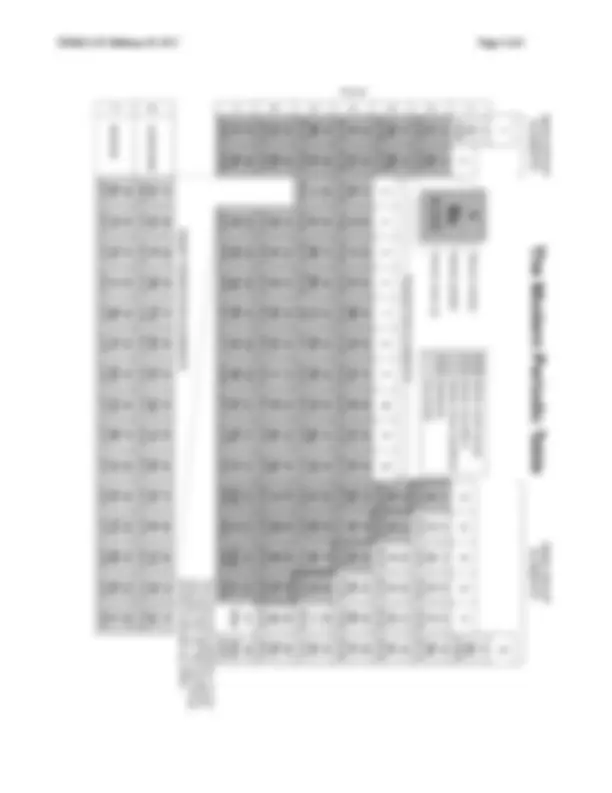






Study with the several resources on Docsity

Earn points by helping other students or get them with a premium plan


Prepare for your exams
Study with the several resources on Docsity

Earn points to download
Earn points by helping other students or get them with a premium plan
Community
Ask the community for help and clear up your study doubts
Discover the best universities in your country according to Docsity users
Free resources
Download our free guides on studying techniques, anxiety management strategies, and thesis advice from Docsity tutors
CHEMISTRY 1311 MIDTERM 1 SOLUTION
Typology: Exams
1 / 8

This page cannot be seen from the preview
Don't miss anything!





Student Number: _______________________________________________________
Question 1. Short answer questions (1 mark each) a) A 5.00 L flask is filled with argon gas at 1.35 atm and 31.0 oC. After a 3.00 mol sample of nitrogen gas is added at this temperature, what is the partial pressure of argon? b) Are the bond energies used to estimate reaction energies exothermic or endothermic? c) At constant pressure an ideal gas inside a piston contracted, involving 250 J of work and releasing 500 J of heat. What is the value of ΔE for the gas in this process? d) A micropipette can remove 1 mL of liquid from a solution to an accuracy of 1 μL. How many significant figures should you use to record the volume of the aliquot of solution removed by this pipette? e) Write the chemical symbol for the element containing 13 protons, 10 electrons and 14 neutrons. f) If the standard heat of formation of liquid H 2 O is - 285 kJ mol-^1 , then what will be the heat of the reverse reaction performed with 0.50 mol of liquid H 2 O? Question 2. Short calculations a) What is the root mean squared speed of an oxygen (O 2 ) molecule at 298 K? (2 marks)
f) What would the concentration of potassium be if a 35.0 mL sample of 0.025 M K 2 SO 4 was added to 50.0 mL of 0.50 M K 3 PO 4? (3 marks) Question 3. A customer to a pawn shop wants to sell a ring weighing 13.8 g. To determine the composition of the ring the pawn shop owner places it into a pot of boiling water. The hot is then transferred to a coffee cup calorimeter containing 25.0 mL of room temperature (25.0oC) water. Using the data in the table below, determine what this ring made out of, given that the temperature of the water in the calorimeter rose to 26. o C? (4 marks) Specific heat capacities (J g
Question 4. Answer the questions below. You may need to use data provided on the equation sheet. a) Calculate the standard combustion enthalpy for liquid butanol. (3 marks) b) Calculate Δ E R^ o e^ action for the standard combustion of liquid butanol. (3 marks) Question 5. Hydrogen gas, H 2 (g) is passed over Fe 2 O 3 (s) at 400oC. Water vapour is formed together with an iron oxide containing 72.3% Fe by mass. What is the empirical formula of this iron oxide? (4 marks)
Constants and Conversion Factors 1 mmHg = 1 torr 760 mmHg = 1 atm 1 atm = 101.325 kPa 1 atm = 1.013125 bar 1 bar = 10 5 Pa 1 cm 3 = 1 mL = 1000 μL 1 dm 3 = 1000 mL = 1 L 1 m 3 = 1000 L 1 cal = 4.184 J 1 L = 1000 mL 1 m = 100 cm 1 m = 10^12 pm Avogadro’s Number NA 6.022x10^23 mol-^1 Gas constant R 8.31451 J·K
Δ H of^ (C 4 H 10 O (^) ( l )) = − 327. 0 kJ mol-^1 Δ H of^ ( H 2 O (^) ( l )) = − 285. 83 kJ mol-^1 Δ H of^ (C O 2 ( g )) = − 393. 5 kJ mol-^1 Δ H (^) f o (H 2 O^ ( g^ )) =^ −^241.^8 kJ^ mol
T (^) (i n K) = T (^) (i n oC) + 273. 15 K n = m M
% Yield = actual yield theoretical yield c (^) (m ol / L) = n V c 1 V 1 = c 2 V 2 = n p = mg A p = dgh pV = nRT p 1 V 1 T 1
p 2 V 2 T 2 pT = p 1 + p 2 + p 3 + … pA = X (^) A × pT X (^) A = nA nT d = m V
p ⋅ M RT
m v^2 E =
v =
Rate A Rate B
p = nRT (^ V^ −^ nb ) − a n 2 V^2 Δ E = w + q w = F × d = − p Δ V q calorimeter = Ccal Δ T Δ E reaction = Σ BE reactant bonds broken − Σ BE product bonds formed Δ E molar =
n Δ H r^ o e^ action= Σ vp Δ H of ,^ p − Σ vr Δ H of , r Δ H reaction = Δ E reaction + RT Δ ngas H = E + pV